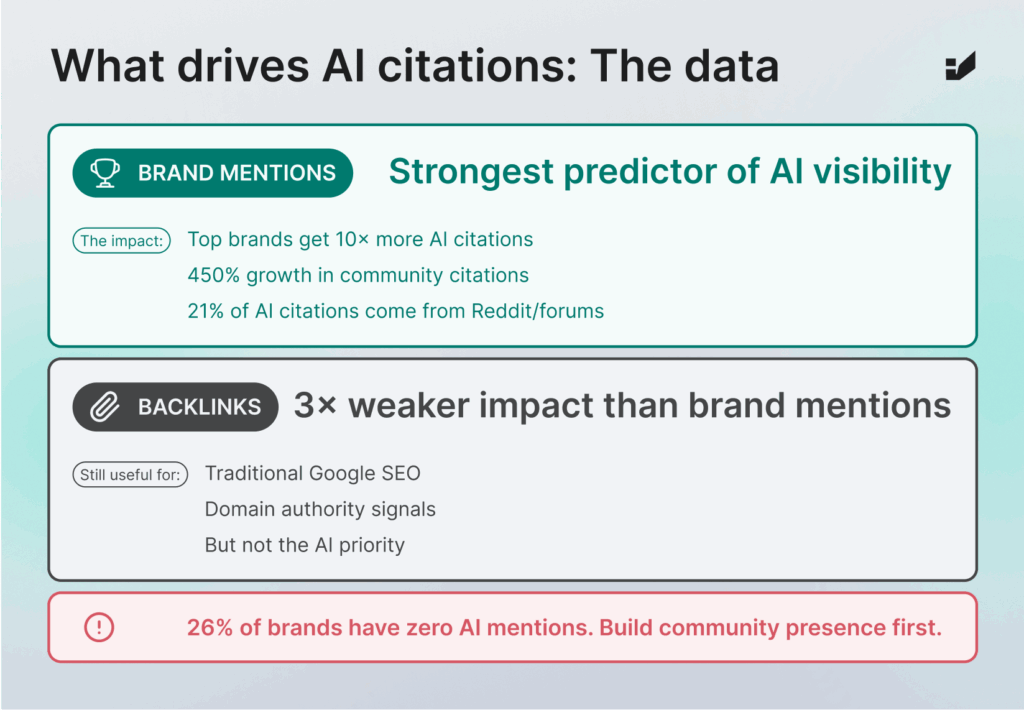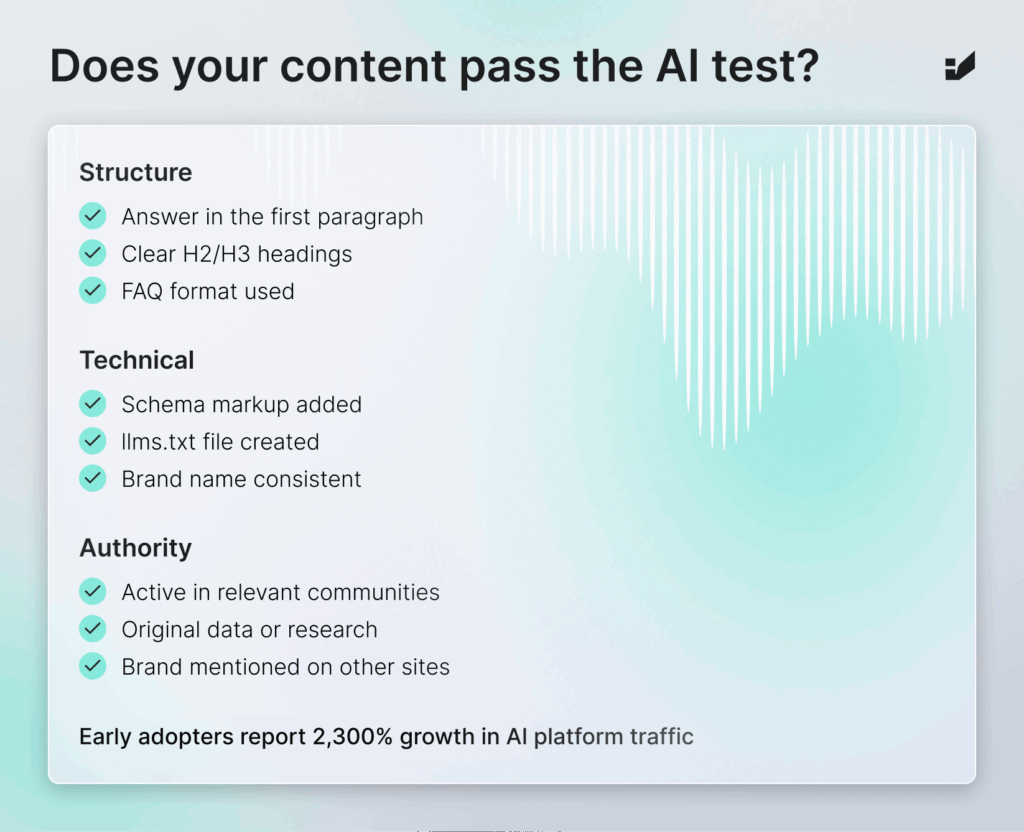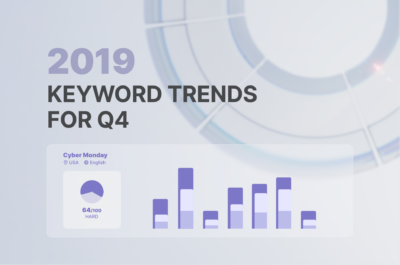The biggest myths about AI Search – what you really need to know
SEO in AI-driven search engines like ChatGPT, Perplexity, Gemini, and Google AI Overviews is becoming a crucial part of digital marketing strategies. As this field grows, many myths have emerged that can seriously hurt your visibility in AI search.

Below are the key misconceptions you need to understand to succeed in optimizing for large language models (LLMs).
Myth 1: “If I rank in Google, I’ll automatically appear in ChatGPT”
Reality: This is one of the most damaging myths in AI search optimization. ChatGPT and other LLMs don’t index web pages in real time like Google does. ChatGPT relies on training data up to a cutoff date (for GPT-4, last updated December 2023), while Perplexity crawls with its own PerplexityBot and additional sources. Studies show the correlation between Google ranking and ChatGPT visibility ranges from 0% to 93%, with an average far lower. Dominating traditional SEO doesn’t guarantee an AI search presence.
Source: https://www.growandconvert.com/ai/google-seo-and-llmo/
What to do: Focus on building brand authority through consistent online mentions, structured content, and implementing schema markup.

Myth 2: “AI will always cite its sources”
Reality: ChatGPT rarely provides citations unless using search plugin integration. Perplexity offers more transparent citations, but that’s not universal across AI platforms. If your domain lacks recognized authority, your content may be used without attribution. Analysis by Ahrefs of 75,000 brands found that 26% had zero mentions in AI Overviews, while top brands enjoyed up to ten times more mentions than lower-ranked competitors.
Source: https://ahrefs.com/blog/ai-overview-brand-correlation/
What to do: Increase brand recognition through consistent naming, proprietary research, and expertise that AI systems can link to your site.
Myth 3: “Longer content equals better AI visibility”
Reality: LLMs don’t “read” like humans – they extract key information. Concise, well-structured content that directly answers specific queries is more likely to be cited than lengthy articles filled with unnecessary details. Perplexity’s three-layer reranking system can discard entire result sets that fail quality thresholds. If your content doesn’t pass these filters, it gets ignored.
Source: https://hueston.co/llmo-ai-seo/perplexity-ai-ranking-factors-llmo-optimization-2025/
What to do: Place the main answer in the opening paragraph, use clear H2/H3 headings, bullet points, and structure content so AI can easily extract the core information.
Myth 4: “AI search is a future concern”
Reality: AI search is already replacing clicks in many sectors, especially developer tools, B2B SaaS, and technical tutorials. Ahrefs research revealed a 54% rise in AI-driven impressions coupled with a 15% drop in clicks over three months – a clear sign of LLM impact. Case studies show 2,300% growth in AI platform traffic after adopting AI search optimization, and some brands saw AI referral traffic surge from single-digit visits to hundreds per month.
Source: https://backlinko.com/llm-seeding
Source: https://thesearchinitiative.com/case-studies/b2b-ai-search
What to do: Implement your AI search strategy now – early adopters will gain a competitive edge.

Myth 5: “Schema markup doesn’t matter for AI”
Reality: This is one of the biggest GEO (Generative Engine Optimization) mistakes you can make. AI crawlers heavily rely on schema markup to understand content. Perplexity uses structured data to interpret context and relationships. Sites without schema markup have far lower chances of appearing in AI answers. Key schema types that boost AI visibility include Organization, Article, FAQ, Review, Product, and LocalBusiness.
Source: https://writesonic.com/blog/geo-generative-engine-optimization-mistakes
What to do: Add schema markup to all critical pages, use standard schema.org types, and regularly test your implementation.
Myth 6: “Just add an llms.txt file and you’re done”
Reality: The llms.txt file is a starting point, not a complete solution. Many AI platforms ignore or don’t support it. It helps AI navigate your site, but doesn’t guarantee visibility. A proper llms.txt should include an H1 project name, a blockquote description, and link lists under H2 headings. Place it at /llms.txt in your domain root.
What to do: Use llms.txt as part of a broader strategy – prioritize content quality and brand authority.
Myth 7: “Brand mentions are just a vanity metric”
Reality: Brand mentions are the strongest correlate of AI Overview visibility (correlation 0.664), far outweighing backlinks (0.218). AI systems treat brand mentions as signals of authority and trustworthiness. Brands in the top quartile for web mentions average 10× more AI Overview mentions than those in the next quartile. User-generated citations (e.g., Reddit) have grown 450% in three months, now comprising over 21% of AI citations.
What to do: Build presence in online communities (Reddit, Quora, LinkedIn), engage in industry discussions, and create content that naturally generates mentions and citations.
Source: https://ahrefs.com/blog/ai-overview-brand-correlation/

Myth 8: “AI optimization undermines traditional SEO”
Reality: Proper AI search strategies often improve Google rankings as well. Case studies show pages optimized for AI achieving over 1,400 first-position AI Overview keywords while also climbing traditional organic results. Correlations between Google and AI rankings vary by company, but they’re generally positive. New sites with low domain ratings may appear in Perplexity but not in ChatGPT due to training data gaps.
Source: https://www.growandconvert.com/ai/google-seo-and-llmo/
What to do: Treat AI optimization and traditional SEO as complementary. Well-structured, authoritative content benefits both ecosystems.
Myth 9: “Just use AI to write content”
Reality: AI-generated content without human oversight is a recipe for disaster. Errors erode trust and visibility. Perplexity applies impression and click-through thresholds – content that underperforms post-publication won’t be promoted. Inconsistent brand messaging across pages and platforms prevents AI from confidently recommending your solutions.
What to do: Use AI as an assistant but maintain human oversight. Rigorously fact-check, keep content fresh, and ensure a consistent brand narrative across channels.

Implementing your AI Search strategy
- Audit current visibility
Use tools like Ahrefs Brand Radar, Keyword.com’s AI brand monitoring, or specialized GEO platforms to track your presence in AI responses. - Content structure
Write conversationally, not just for keywords. Lead with answers, use FAQ formats, and maintain a clear heading hierarchy. - Brand building
Grow authority through guest posts, expert interviews, industry reports, and active participation in online communities. - Technical optimization
Apply comprehensive schema markup, optimize crawl efficiency, and include an llms.txt file as a supporting element. - Measurement
Monitor AI referral traffic in Google Analytics, track brand mentions across the web, and measure direct traffic growth as indicators of AI impact.
AI search optimization is happening right now. Companies that ignore these changes risk losing visibility precisely when potential customers make purchase decisions. Understand these myths, focus on authority building, and create content that AI systems will want to cite.



